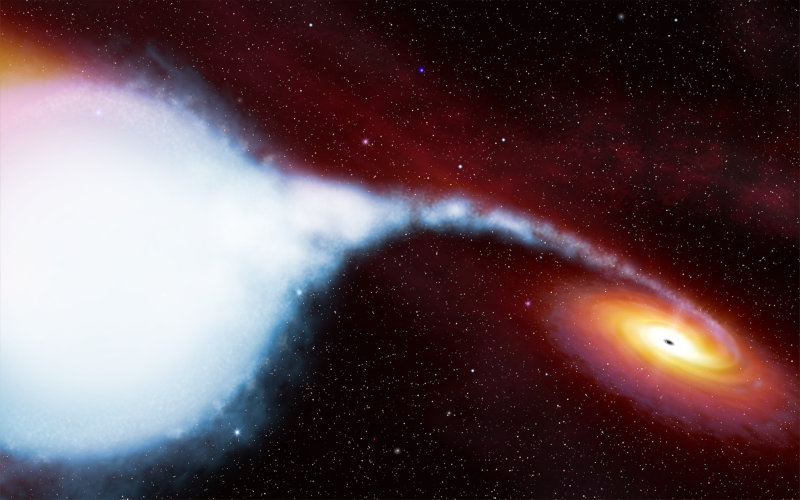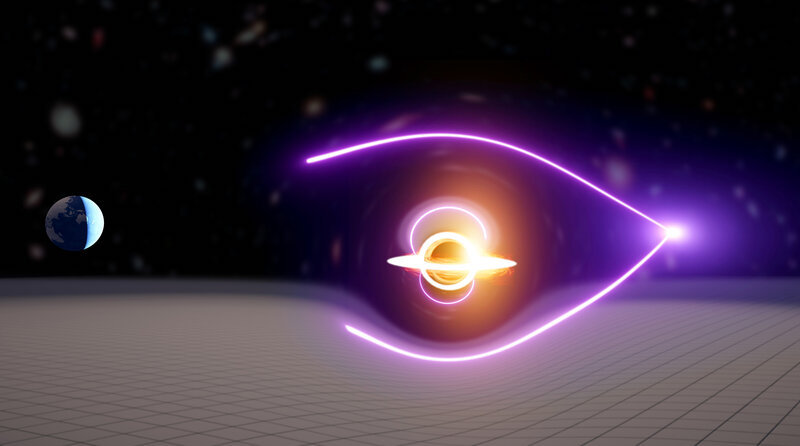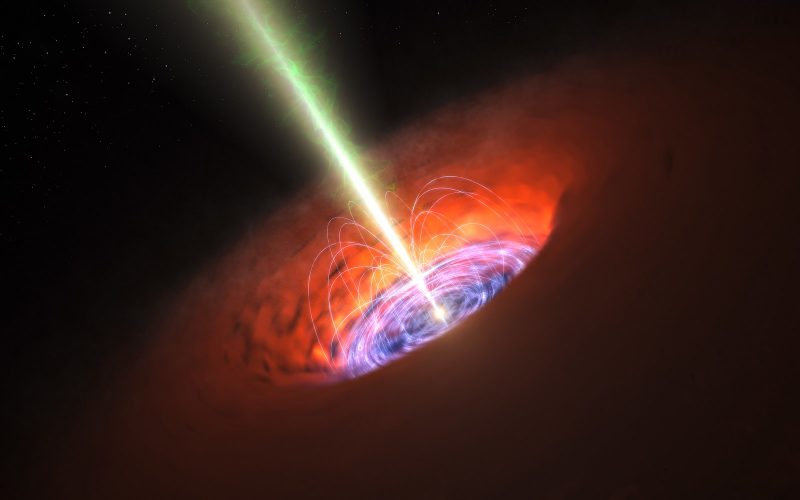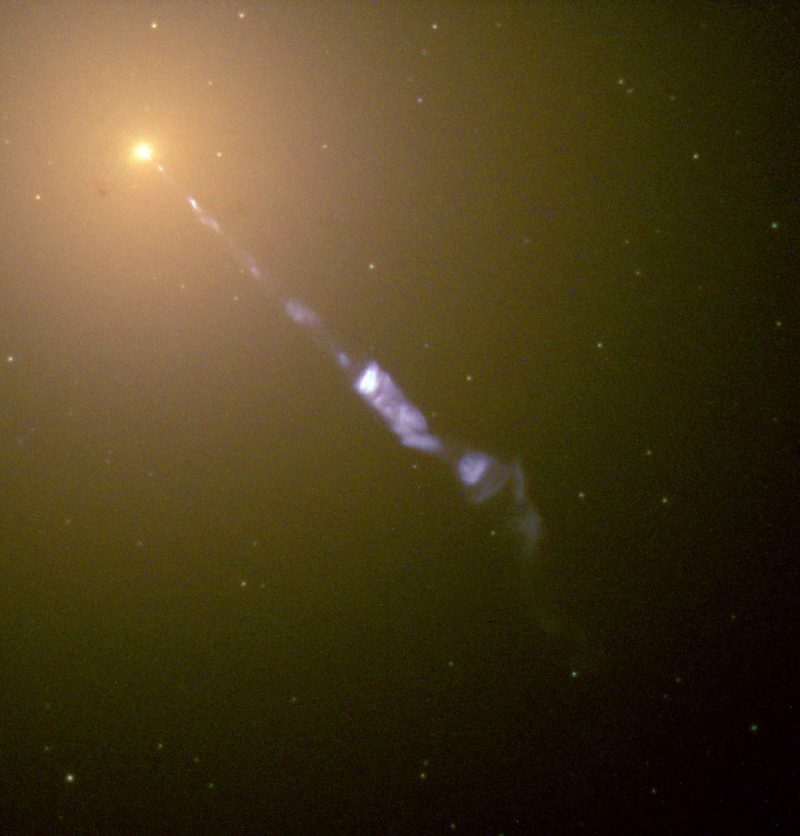
What are black holes?
A black hole have such strong gravity that nothing, not even light, can escape it. That’s why black holes are black. We can’t see them directly. But we can see the effects black holes have on the space around them. Black holes can be as large as the mass of millions or billions of stars. Or they can be as small as a few stellar masses crushed to an extreme density during supernova explosions. And last year we learned that intermediate-mass black holes exist, too. Plus, there may even be micro black holes.
From theory to reality
In his general theory of relativity from 1915, Albert Einstein was the first to suggest that our universe contains such strange, dense, massive objects. Black holes emerge from Einstein’s equations of general relativity as a natural consequence of the death and collapse of massive stars. In 1916, German mathematician Karl Schwarzschild was the first person to formulate black holes mathematically. Theoretical physicist John Wheeler first coined the name black hole many years later, in 1967.
Up until the 1970s, black holes were mathematical curiosities only. Then, in 1971, scientists discovered the first physical black hole, Cygnux X-1.
Stellar-mass black holes
We know of three types of black holes. The first is the so-called stellar-mass black hole. These are the remnants of huge stars. When, at the end of its life, a star with more than about five times the mass of our sun explodes as a supernova, gravity compresses its core suddenly and violently.
Depending on the star’s mass, the collapse may halt and form a neutron star. But if its mass is sufficient, the core’s collapse will continue, forming a black hole. Stellar-mass black holes have masses ranging from a minimum of about five times the mass of our sun up to about 60 times the sun’s mass. Their diameter is typically between 10 and 30 miles (16-48 km).

Intermediate black holes
Scientists announced the discovery of an intermediate-mass black hole in 2021. This type of black hole bridges the gap between smaller, stellar-mass black holes and supermassive black holes that lurk at the center of galaxies. The newly discovered “goldilocks” black hole has a mass of 55,000 suns. The astronomers found the intermediate black hole by detecting something located far behind it: the signals from a gamma ray burst. The gravitational lensing of the burst’s emission clued scientists in to the intermediate-mass black hole.

Supermassive black holes
The third type of black hole is the supermassive black hole. These can have the mass of billions of suns. Astronomers believe that most galaxies have supermassive black holes at their cores. The one at the center of our own Milky Way galaxy, Sagittarius A*, has some 4 million times our sun’s mass and is some 37 million miles in diameter.
Another example of a supermassive black hole is at the center of the quasar known as TON 618. Its central black hole has an estimated 66 billion solar masses. Supermassive black holes may have formed in the early history of the universe from huge collapsing clouds of interstellar hydrogen, although their exact origin is unclear and is an area of much active research. They may also have accumulated extra mass over the eons from mergers with other black holes.

A 4th type of black hole
There may be yet another category of black hole, that of the micro black hole. These would be smaller in size to a stellar-mass black hole. As of yet, they are still only hypothetical and none has been proven to exist.
What’s inside a black hole?
By definition, we can’t observe what’s inside a black hole, because no light – no information of any kind – can escape. But astrophysical theories suggest that, at the core of a black hole, all the black hole’s mass is concentrated into a tiny point of infinite density. This point is known as a singularity.
It is this point – this singularity – that generates the black hole’s incredibly strong gravitational field. Consider, however, that the singularity might not exist. That’s because all known physics breaks down under the extreme conditions at the center of a black hole, where quantum effects doubtless play a large part. As we do not yet possess a quantum theory of gravity, it is impossible to describe what actually exists at core of a black hole.
The limits of a black hole
The boundary of a black hole is its event horizon. It is not a physical edge. It’s just a point in space beyond which it is impossible to escape the black hole’s gravity. Once anything falling into the black hole passes the event horizon, it can never leave the black hole again. It draws inexorably and inevitably toward the black hole’s center. Within the event horizon, any solid object is torn apart by the fierce gravity and reduced to its constituent subatomic particles. At the event horizon, the escape velocity of the black hole reaches the speed of light.
Observing black holes
With no emission from a black hole, scientists can only observe their gravitational effects on nearby objects in space. If there are stars or gas near the black hole, it may be actively “feeding” on them. That is, a black hole may draw in material from these nearby objects. In this case, a black hole will have an accretion disk. This is where material spirals inward before the black hole eats it, like water down a drain. The accretion disk may rotate at significant percentages of the speed of light: Friction between colliding particles in the disk raises its temperature to million of degrees, radiating huge quantities of X-rays that can be detected with special telescopes.
In April 2019, the Event Horizon Telescope project revealed the first-ever direct image of a black hole, the supermassive black hole at the center of the giant elliptical galaxy M87. A global array of radio telescopes acquired the image. It demonstrated beyond reasonable doubt that black holes exist. Scientists were able to directly test General Relativity’s models of black hole behavior and found that M87’s black hole complied perfectly.

Bottom line: A black hole is an area of space with a gravitational field so strong that nothing, not even light, can escape it. Black holes come in three sizes, possibly four.











